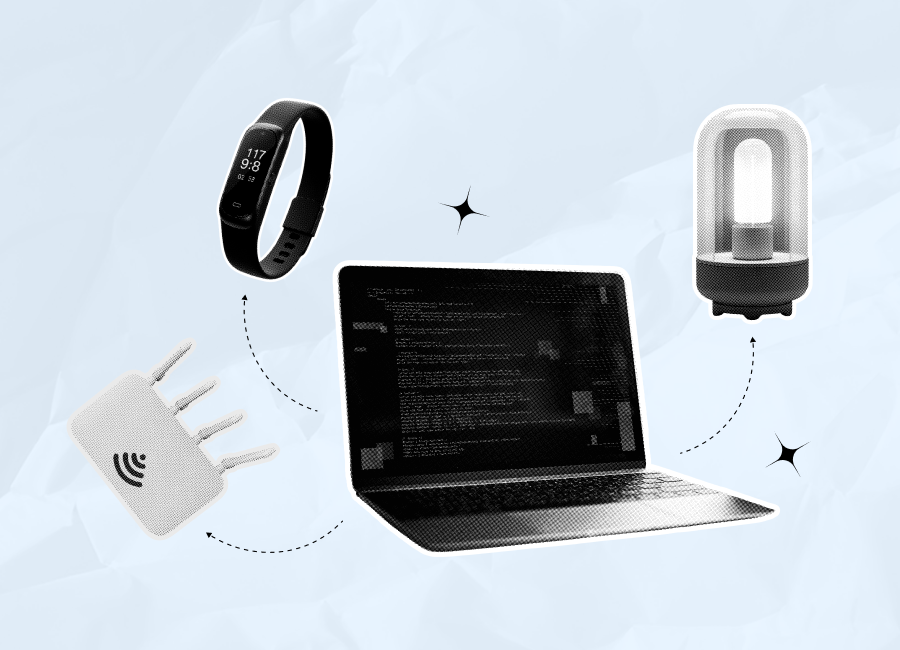Demand for mobile applications has been growing constantly in recent years, as have the number of apps developed and launched in various spheres. In this article, we’ll take a look at mobile app development trends that rule the market in 2025.
Mobile app development market: A quick overview
Total revenue in the application market hit more than $475 billion in 2022, while in 2024 it is expected to reach $540 billion. Forecasts for 2027 are even more optimistic; experts believe this figure will surpass $750 billion, with the highest revenue coming in the gaming sector.
With smartphone penetration rates climbing worldwide (in 2022 this figure was 68%), users’ tech literacy is rising too. This allows businesses to create more advanced and complicated solutions for addressing people’s needs.
Top 15 latest mobile app development trends in 2025
The latest trends in mobile app development mirror general trends in the tech world. With our rich experience in delivering custom mobile app development services to companies working in a variety of industries, we can identify the most important of them.

Artificial intelligence
AI has become a real buzzword in mobile app development. AI tools can collect and process valuable data in various formats related to how people interact with the app and users’ behavior patterns. AI-powered applications gain insights into what people want, what they’re looking for, and what solutions can better address their needs.
Among the most popular uses of this technology are highly personalized recommendations for users in eCommerce apps, creation of individual educational plans for people based on their skills and knowledge in eLearning apps, and the use of AI algorithms in training and dieting plans.
Applying the capabilities of ChatGPT is one reflection of this trend. The language model introduced by OpenAI greatly expands opportunities for processing and responding to natural language inputs. Using ChatGPT improves the search functionality of apps as well as generating text and creating personalized content.
Internet of Things
Use of IoT-powered features is one of the main application development trends. This isn’t exactly new technology anymore, but it still occupies an important position in the tech landscape. Smart devices and sensors give mobile apps access to various types of data in real time, which helps developers significantly expand app functionality.
IoT is widely used in building solutions for healthcare, sports, fitness, logistics, and manufacturing industries.
Collected data can be efficiently processed to provide users with insights into real-time changes in various factors. These tools play a crucial role in helping users to make the right decisions and to react in a timely way to various situations.
We can’t speak of IoT without mentioning apps for wearables. Thanks to the progress made in the sphere of smartwatch design, it is possible to create feature-rich applications that can practically fully replace their “clones” developed for smartphones. Nevertheless, as a rule, users are expected to download a smartphone app in combination with a mobile solution that it will be synchronized with. As a result, the same data and functionality will be available from both devices.
AR and VR
With every passing year, virtual reality is becoming more real! Today AR and VR tools mean more than just creating virtual backgrounds during video calls or adding funny masks and filters to your selfies, uses that were popular a few years back. The introduction of Apple’s first augmented reality headset, Vision Pro, has become a crucial milestone in the development of this technology. Expectations for VR and AR solutions are moving higher, which means that both device manufacturers and app developers should do their best to meet them.
VR and AR features are gaining popularity in many segments, such as eCommerce mobile apps or mobile app development for the education industry. For example, thanks to AR tools, you can check how real-life furnishings will appear in your surroundings before you buy them. And VR can be a powerful training tool in many fields, helping to create and demonstrate objects and environments not available in real life.
Apps for smartphones with foldable screens
A few years ago, smartphones had a rather standard look and the main task for developers was to make apps compatible with different screen sizes, but now the task is more challenging. Mobile phones with foldable screens are being introduced by various manufacturers, and it’s important to bear this in mind when designing and developing apps. These screens are bigger and may allow users to open multiple windows at once.
Mobile-first banking
Mobile banking software is definitely not the newest development in the tech sphere. While apps were once used merely as a support in delivering banking services, today there are numerous neobanks, such as N26 or Chime Bank, that focus on mobile-first banking and are actively revolutionizing the way financial services are delivered.
Mobile banking apps make payments and transactions faster and safer than they used to be. Many people are already accustomed to these new standards and are looking for new applications that can facilitate and streamline financial transactions in their professional and private lives.
Increased demand for telemedicine apps
Remote medical services are gradually becoming a standard for the healthcare industry. Of course, they will never replace face-to-face appointments with doctors. However, they can facilitate many tasks for patients and medical staff, reduce loads for doctors, and streamline the process of getting healthcare consultations. Such apps are usually equipped with videoconferencing features. You can read more about telemedicine app development on our blog.
Super apps
The time is past when an application was built for solving only one task. Users don’t want to download a separate app for each function. It’s much more convenient to install an all-in-one solution that will do a lot of things. That’s been the trend in mobile app development in Asia for a while, but now such “super apps” are gaining popularity in Western countries as well.
WeChat and OMNi are some popular examples of multi-functional super apps. WeChat is a Chinese messaging application but also has dozens of mini services, including live streaming, shopping, food delivery ordering, and many others. OMNi is one of the most popular apps in Central America, offering access to many services related to transportation, healthcare, and finance.
Growing role of 5G technology
5G is a new wireless standard that has come to replace 4G. It can support more connections and deliver data much faster than its predecessors. In other words, all the processes carried out online can become much more efficient. The advent of 5G has had a direct impact on the development of mobile apps. Thanks to faster data exchange, lower latency, and higher resolution, video streaming mobile services can be enhanced. Mobile financial transactions can be performed faster and in a more protected way. And in general, developers can enrich their applications with numerous advanced features without fear that the app’s performance will suffer.
Mobile learning apps
eLearning has become an integral part of the educational system. But the hectic lifestyle and mobility of users have boosted interest in mobile-friendly solutions. Though it can be convenient to learn a language, for example, sitting with your laptop, it’s even more convenient to get access to learning materials and tests directly on your smartphone. It means learning doesn’t need to stop during trips, vacations, and long commutes.
Audio-focused functionality and social media applications
Text messengers and image- and video-centered apps are well known to everyone. But a new format is ready to compete in the market. Chatrooms that allow users to exchange audio messages instead of text are a convenient way to share your thoughts on the go.
There can be some challenges when it comes to integrating such a solution with existing social media apps. When building a sharing feature, it’s important to remember that the majority of social media platforms support the exchange of video clips but offer no such functionality for audio files. Nevertheless, there are already some solutions that can turn audio clips into videos for sharing them with external platforms.
Mobile commerce solutions
We know eCommerce is efficient and popular. But now more and more people are looking for ways to place orders directly from their smartphones. Many businesses launch mobile-friendly versions of their websites, but launching a separate mobile application has become a more feasible solution. Such apps usually have the same functionality as traditional web eCommerce platforms, but their interfaces are adjusted to the screens of mobile devices. They can also be enriched with traditional features of mobile software products, such as push notifications and biometric identification.
Blockchain-powered solutions
As a rule, the wide audience knows about blockchain in the context of cryptocurrencies. However, the use of blockchain need not be limited to crypto assets. This technology offers a lot of possibilities for building decentralized applications. Smart contracts that run on blockchain can help many businesses increase the transparency and reliability of their transactions as well as eliminate intermediaries.
Privacy and data security
Hackers today have powerful tools and sophisticated approaches that allow them to get access to valuable data processed and stored by mobile applications. This means that developers need to pay special attention to data protection issues. Two-factor authentication, biometry, and other verification tools are much more than just another mobile app development trend. Today they are irreplaceable features of any mobile solution, especially those dealing with personal or banking details.
Touchless UI
Touchless interfaces are in high demand in mobile app development. You might ask how it’s possible to interact with an app without touching the screen. The answer is unexpectedly simple: it’s possible to do it with the help of gestures, a move of your head, or a move of your device. It’s expected that, soon, apps will also be able to understand the movements of your eyes for scrolling.
Hyperpersonalization
From a business perspective, it may be easiest to offer the same products and sets of services to everyone. But this model doesn’t work in 2025. Consumers expect to get highly personalized offers that can fully satisfy their needs. The idea here is to study users’ preferences and create a variety of scenarios for an app. As a result, this application will be able to put together individual recommendations and even change the content and design of its interfaces in accordance with users’ preferences and typical behavior.
Looking for a development team that will build a mobile app for you?
With our expertise in this sphere and a deep understanding of different business domains, we can cope with tasks of any complexity!
Conclusion
As the number of mobile apps is growing rapidly, you’ll want to make your solution stand out from the crowd. Taking into account current mobile app development trends is a must when building a software product.
If you have an idea for creating a mobile application, we will be happy to help you. With outstanding practical skills and the deep knowledge of our developers, we are able to offer you a unique solution created in accordance with the latest trends in mobile app development. Contact us to discuss the ways we might cooperate with you on your project.
FAQ
What are some of the latest trends in web and mobile device applications?
Software development trends always reflect the demands and expectations of users. Today these major trends include:
- AI applications;
- IoT-powered apps and applications connected to wearable devices;
- AR and VR;
- Hyperpersonalization;
- Increased focus on app security.
How much does it cost to develop a mobile app in 2025?
The cost of mobile app development solutions depends on a wide range of factors, including but not limited to the desired functionality, project complexity, and scope of work. When you start cooperating with a development team, you’ll get an estimate based on the requirements for your product and will be able to better plan your budget.










































